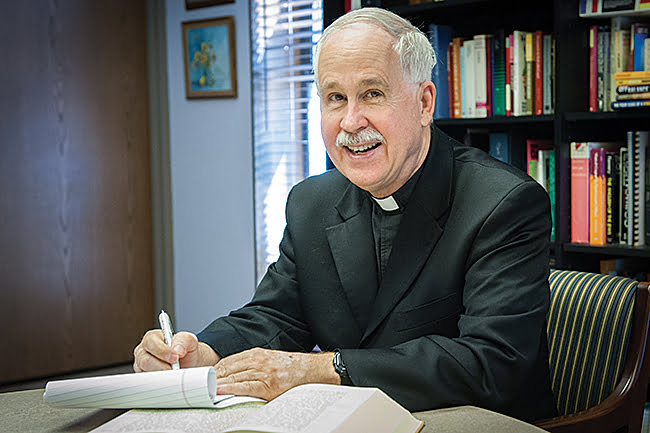
Father Mike Stubbs is the pastor of Holy Cross Parish in Overland Park and has a degree in Scripture from Harvard University.
by Father Mike Stubbs
“Behold, the Lamb of God, who takes away the sin of the world.”
These words, which we hear so frequently before we receive holy Communion, may suggest to us the image of an innocent and tender creature, meek and mild. But that is not what John the Baptist intends when he proclaims them in Sunday’s Gospel reading, Jn 1:29-34.
Lambs were frequently the animal of sacrifice in the Temple of Jerusalem. By calling Jesus “the Lamb of God,” John was anticipating Jesus’ death on the cross, the sacrifice that would take away the sin of the world.
Beyond this description of Jesus as a sacrificial animal, the title of Lamb of God also points to Jesus as a powerful adversary of evil. This understanding of the Lamb of God is further amplified in Rv 5:6: “Then I saw standing in the midst of the throne and the four living creatures and the elders, a Lamb that seemed to have been slain. He had seven horns and seven eyes.”
In Near Eastern culture, the horn represented great strength. The number seven stands for fullness or completion. Taken literally, the image of a lamb with seven horns would look bizarre. But, symbolically, it means a lamb that is almighty.
Similarly, the seven eyes mean that the lamb is all-seeing. The Book of Revelation is proclaiming the Lamb of God, who is all-powerful and all-seeing. This is no meek lamb, but an immensely powerful ram.
As the Lamb of God, Jesus has defeated the forces of evil by his death on the cross. And just as important, he is risen from the dead. Jesus’ resurrection is signaled in the passage from Revelation by the mention that the lamb is “standing in the midst of the throne,” even though it “seemed to have been slain.” In the Greek language, the language in which the New Testament was written, the word “rise” or “resurrect” literally means “to stand again.” This is a clear reference to Jesus’ resurrection.
John the Baptist is proclaiming Jesus as the powerful adversary of evil, who will take away the sin of the world by his death on the cross. The priest who echoes those words is similarly pointing to Jesus as the one who will save us by his sacrifice on the cross.
We come into contact with that saving sacrifice with the Lamb of God when we receive holy Communion.

